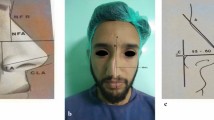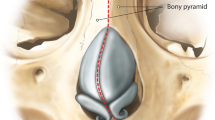Abstract
Objectives
Correction of crooked nose with long-term functional and aesthetic success remains a great challenge for rhinoplasty surgeons. The aim of this study was to present the aesthetic and functional results of the cross-spreader graft technique applied for the correction of I-shaped crooked nose.
Methods
A retrospective examination was made of 25 patients applied with open technique rhinoplasty using cross-spreader graft for the correction of I-shaped crooked nose between March 2016 and June 2019. The functional results of the patients were evaluated using the Nasal Obstruction Symptoms Evaluation scale. The Rhinoplasty Outcomes Evaluation was used to evaluate the subjective aesthetic results, and the external nose deviation angle was measured from the frontal aspect to evaluate the objective aesthetic results.
Results
Evaluation was made of 25 patients comprising 11 males and 14 females with a mean age of 26.64±7.08 years. The post-operative mean NOSE and ROE scores were significantly improved compared to the preoperative values (p<0.001). A statistically significant improvement was determined in the deviation angle values from preoperative to postoperative (p< 0.001).
Conclusion
According to the current study functional and aesthetic results of the cross-spreader graft technique applied for the correction of I-shaped crooked nose, this new technique appears to be an effective method for the treatment of I-shaped crooked nose deformity.
Level of Evidence IV
This journal requires that authors assign a level of evidence to each article. For a full description of these Evidence-Based Medicine ratings, please refer to the Table of Contents or the online Instructions to Authors www.springer.com/00266.




Similar content being viewed by others
References
Dingman R (1956) Correction of nasal deformities due to defects of the septum. Plast Reconstr Surg 18:291–304
Hsiao YC, Kao CH, Wang HW, Moe KS (2007) A surgical algorithm using open rhinoplasty for correction of traumatic twisted nose. Aesthet Plast Surg 31:250–258
Inanli S, Binnetoglu A (2016) A combined approach to crooked nose deformity. Aesthet Plast Surg 40:360–366
Erdem T, Ozturan O (2008) Objective measurement of the deviated nose and a review of surgical techniques for correction. Rhinology 46:56
Stepnick D, Guyuron B (2010) Surgical treatment of the crooked nose. Clin Plast Surg 37:313–325
Rohrich R, Gunter J, Deuber M, Adams WP (2002) The deviated nose: optimizing results using a simplified classification and algorithmic approach. Plast Reconstr Surg 110:1509–1523
Boccieri A (2013) The crooked nose. Acta Otorhinolaryngol Ital 33:163–168
Lawson W, Reind AJ (1994) Correcting functional problems. Facial Plast Surg Clin North Am 2:501–520
Özyazgan İ (2017) Septal deviation treatment using bone or cartilage grafts fixed with cyanoacrylate tissue adhesive. Aesthet Plast Surg 41:618–627
Baykal B, Erdim I, Guvey A, Oghan F, Kayhan FT (2016) Caudal septal stabilization suturing technique to treat crooked noses. J Craniofac Surg 27:1830–1833
Gubisch W (2015) Treatment of the scoliotic nose with extracorporeal septoplasty. Facial Plast Surg Clin North Am 23:11–22
Wilson MA, Mobley SR (2011) Extracorporeal septoplasty: complications and new techniques. Arch Facial Plast Surg 13:85–90
Rezaeian F, Gubisch W, Janku D, Haack S (2016) New suturing techniques to reconstruct the keystone area in extracorporeal septoplasty. Plast Reconstr Surg 138:374–382
Boccieri A, Pascali M (2003) Septal crossbar graft for the correction of the crooked nose. Plast Reconstr Surg 111:629–638
Cabbarzade C (2019) A promising new technique for correcting a deviated nose: partial disarticulation of keystone area. J Craniofac Surg 30:2586–2589
Funding
None
Author information
Authors and Affiliations
Corresponding author
Ethics declarations
Conflict of interest
The authors declare that they have no conflict of interest to disclose and received no financial support.
Ethical Approval
All procedures performed in this study involving human participants were in accordance with the ethical standards of the institutional and/or national research committee and with the 1964 Helsinki Declaration and its later amendments or comparable ethical standards, and all patients provided written informed consent prior to enrolment.
Informed Consent
Informed consent was obtained from all individual participants included in this study.
Additional information
Publisher's Note
Springer Nature remains neutral with regard to jurisdictional claims in published maps and institutional affiliations.
Rights and permissions
About this article
Cite this article
Kavuzlu, A., Şahin, E. A Useful Approach to I-Shaped Crooked Nose Correction: Cross-Spreader Graft Technique. Aesth Plast Surg 46, 833–840 (2022). https://doi.org/10.1007/s00266-021-02571-2
Received:
Accepted:
Published:
Issue Date:
DOI: https://doi.org/10.1007/s00266-021-02571-2




